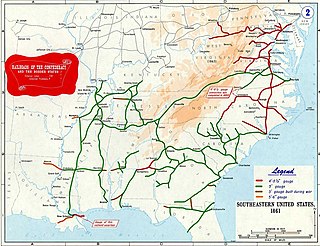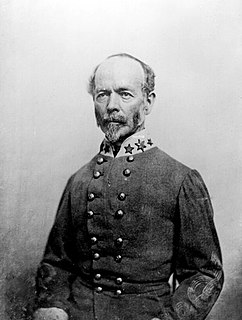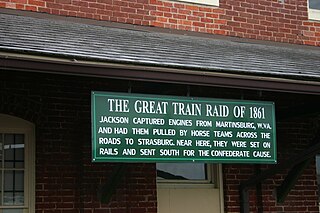
The Second Battle of Bull Run or Battle of Second Manassas was fought August 29–30, 1862, in Prince William County, Virginia, as part of the American Civil War. It was the culmination of the Northern Virginia Campaign waged by Confederate Gen. Robert E. Lee's Army of Northern Virginia against Union Maj. Gen. John Pope's Army of Virginia, and a battle of much larger scale and numbers than the First Battle of Bull Run fought on July 21, 1861 on the same ground.

The First Battle of Bull Run, also known as the Battle of First Manassas, was the first major battle of the American Civil War. The battle was fought on July 21, 1861, in Prince William County, Virginia, just north of the city of Manassas and about 30 miles west-southwest of Washington, D.C. The Union's forces were slow in positioning themselves, allowing Confederate reinforcements time to arrive by rail. Each side had about 18,000 poorly trained and poorly led troops in their first battle. It was a Confederate victory, followed by a disorganized retreat of the Union forces.

The Peninsula campaign of the American Civil War was a major Union operation launched in southeastern Virginia from March through July 1862, the first large-scale offensive in the Eastern Theater. The operation, commanded by Maj. Gen. George B. McClellan, was an amphibious turning movement against the Confederate States Army in Northern Virginia, intended to capture the Confederate capital of Richmond. McClellan was initially successful against the equally cautious General Joseph E. Johnston, but the emergence of the more aggressive General Robert E. Lee turned the subsequent Seven Days Battles into a humiliating Union defeat.

The Confederate Army of the Potomac, whose name was short-lived, was the command under Brig. Gen. P. G. T. Beauregard in the early days of the American Civil War. Its only major combat action was the First Battle of Bull Run. Afterwards, the Army of the Shenandoah was merged into the Army of the Potomac with Gen. Joseph E. Johnston, the commander of the Shenandoah, taking command. The Army of the Potomac was renamed the Army of Northern Virginia on March 14, 1862, with Beauregard's original army eventually becoming the First Corps, Army of Northern Virginia.

The Orange and Alexandria Railroad (O&A) was a railroad in Virginia, United States. Chartered in 1848, it eventually extended from Alexandria to Gordonsville, with another section from Charlottesville to Lynchburg. The road played a crucial role in the American Civil War, saw the first of many mergers in 1867, and eventually became an important part of the modern-day Norfolk Southern rail system.

The Battle of Blackburn's Ford took place on July 18, 1861, in the Confederate state of Virginia, as part of the Manassas campaign of the American Civil War. Union general Irvin McDowell's Army of Northeastern Virginia was marching south towards the Confederate capitol of Richmond, and encountered the Confederate Army of the Potomac under the command of P. G. T. Beauregard. McDowell sent troops from Daniel Tyler's division to probe the Confederate defenses along Bull Run Creek to locate the Confederate left flank. At Blackburn's Ford, the Union troops attempted to cross but Confederate fire broke up the attack. The repulse at Blackburn's Ford led McDowell to seek to attack the Confederates at a different point along their line, leading to the First Battle of Bull Run days later.

The Battle of Cockpit Point, the Battle of Freestone Point, or the Battle of Shipping Point, took place on January 3, 1862, in Prince William County, Virginia, as part of the blockade of the Potomac River during the American Civil War.

The Bristoe campaign was a series of minor battles fought in Virginia during October and November 1863, in the American Civil War. Maj. Gen. George G. Meade, commanding the Union Army of the Potomac, began to maneuver in an unsuccessful attempt to defeat Gen. Robert E. Lee's Army of Northern Virginia. Lee countered with a turning movement, which caused Meade to withdraw his army back toward Centreville. Lee struck at Bristoe Station on October 14, but suffered losses in two brigades and withdrew. As Meade followed south once again, the Union army smashed a Confederate defensive bridgehead at Rappahannock Station on November 7 and drove Lee back across the Rapidan River. Along with the infantry battles, the cavalry forces of the armies fought at Auburn on October 13, again at Auburn on October 14, and at Buckland Mills on October 19.

The northern Virginia campaign, also known as the second Bull Run campaign or second Manassas campaign, was a series of battles fought in Virginia during August and September 1862 in the Eastern Theater of the American Civil War. Confederate General Robert E. Lee followed up his successes of the Seven Days Battles in the Peninsula campaign by moving north toward Washington, D.C., and defeating Maj. Gen. John Pope and his Army of Virginia.

The American Civil War was the first in which large armies depended heavily on railroads to bring supplies. For the Confederate States Army, the system was fragile and was designed for short hauls of cotton to the nearest river or ocean port. During the war, new parts were hard to obtain, and the system deteriorated from overuse, lack of maintenance, and systematic destruction by Union raiders.

The Army of the Shenandoah was an army of the Confederate States of America during the American Civil War; it was organized to defend the Shenandoah Valley of Virginia in the early months of the war. The army was transferred to reinforce the Confederate Army of the Potomac at the First Battle of Bull Run, which was its only major action. After the battle, the army was merged into the Army of the Potomac.

The Eastern Theater of the American Civil War consisted of the major military and naval operations in the states of Virginia, West Virginia, Maryland, and Pennsylvania, the District of Columbia, and the coastal fortifications and seaports of North Carolina.

The U.S. Military Railroad (USMRR) was established by the United States War Department as a separate agency to operate any rail lines seized by the government during the American Civil War. An Act of Congress of 31 January 1862 authorized President Abraham Lincoln to seize control of the railroads and telegraph for military use in January 1862. In practice, however, the USMRR restricted its authority to Southern rail lines captured in the course of the war. As a separate organization for rail transportation the USMRR is one of the predecessors of the modern United States Army Transportation Corps.

Colonel Stonewall Jackson's operations against the Baltimore and Ohio Railroad in 1861 were aimed at disrupting the critical railroad used heavily by the opposing Union Army as a major supply route. A second goal was to capture the maximum number of locomotives and cars for use in the Confederate States of America. During this point in the war, the state of Maryland's stance was not yet determined. The B&O Railroad, then owned by the state of Maryland, ran through Maryland and along the Potomac River Valley in its pass through the Appalachian Mountains, but took a crucial turn at Harpers Ferry and passed south, through Virginia and Martinsburg while crossing the Shenandoah Valley. The railroad then continued on through much of present-day West Virginia, which then was still part of Virginia, meaning that a major portion of the route went through a state which later seceded.
The Manassas Gap Railroad (MGRR) ran from Mount Jackson, Virginia, to the Orange and Alexandria Railroad's Manassas Junction, which later became the city of Manassas, Virginia. Chartered by the Virginia General Assembly in 1850, the MGRR was a 4 ft 8 in narrow gauge line whose 90 completed miles of track included 38 miles (61 km) of 60 pounds-per-yard T-rail and 52 miles (84 km) of 52 pounds-per-yard T-rail. A total of nine locomotives and 232 cars were operated on the line, serving 20 stations.
The Winchester and Potomac Railroad (W&P) was a railroad in the southern United States, which ran from Winchester, Virginia, to Harpers Ferry, West Virginia, on the Potomac River, at a junction with the Baltimore and Ohio Railroad (B&O). It played a key role in early train raids of the B&O during the beginning months of the American Civil War.
The 7th Maine Infantry Regiment was an infantry regiment that served in the Union Army during the American Civil War. It participated in most of the campaigns and battles of the Army of the Potomac in the Eastern Theater.
Fort Worth was a timber and earthwork fortification constructed west of Alexandria, Virginia as part of the defenses of Washington, D.C. during the American Civil War.

Fort Ellsworth was a timber and earthwork fortification constructed west of Alexandria, Virginia, as part of the defenses of Washington, D.C. during the American Civil War. Built in the weeks following the Union defeat at Bull Run, Fort Ellsworth was situated on a hill north of Hunting Creek, and Cameron Run,. From its position on one of the highest points west of Alexandria, the fort overlooked the Orange and Alexandria Railroad, the Little River Turnpike, and the southern approaches to the city of Alexandria, the largest settlement in Union-occupied Northern Virginia.

The Manassas campaign was a series of military engagements in the Eastern Theater of the American Civil War.


















